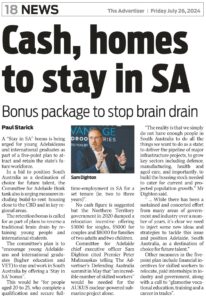The Committee for Adelaide has released the second in a series of 5-Point Plans that is intended to spark discussion, influence policy, catalyse action and drive positive outcomes for Adelaide, South Australia.
The Committee’s ‘5 Actions to Attract and Retain South Australia’s Future Workforce’ sets out new and existing strategies to position Adelaide, South Australia as a destination of choice for skilled workers and future talent.
Click here to view the 5 Actions in further detail.
Aligning with our key pillar of ‘Thriving Community’, the suggested actions draw on ideas and recommendations from our members and subject-matter experts put forward through a series of conversations, surveys and workshops held at the end of 2023 and the first half of 2024.
Like many other cities, Adelaide is in a global race for talent, with workforce shortages continuing to be felt across the board and across most industries. The Committee for Adelaide’s latest Benchmarking Adelaide report revealed that for all-round talent availability and capability, Adelaide places in the bottom 25% of 100 global cities. A recent South Australian business poll also revealed an average of 56.2% of businesses have reported experiencing staff and skill shortages over the March 2024 quarter, with over 37% of businesses reporting a ‘misalignment between the skills required and the skills available in the labour market.’
As a state, we have long grappled with the need to “reverse the brain drain” and attract and retain skilled talent. The reality is that we simply do not have enough people in South Australia to do all the things we want to do as a state, to deliver the pipeline of major infrastructure projects, to grow key sectors including defence, manufacturing, health, and aged care, and importantly, to build the housing stock needed to cater for current and projected population growth.
The Committee recognises that the State Government is partnering with the private sector to equip the state’s future workforce and to take a holistic approach to meeting the state’s unique skills and workforce needs, including a new skills policy to drive reform, significant investment in skills and training, the creation of new technical colleges, fee-free TAFE courses and sector-specific workforce strategies. Industry also has a role to play to recruit, retain, plan, and invest in future workforce requirements.
While there has been a sustained and concerted effort from many areas of government and industry over a number of years, it’s clear we need to inject some new ideas and strategies to tackle this issue.
To help address this issue, the Committee has identified 5-key actions to attract and retain South Australia’s future workforce:
- Incentivise skilled workers to South Australia
- Build-to-Rent housing close to CBD and in key regional areas
- Glamourise vocational education, training, and a career in trades
- Retain young people including international students
- Support businesses to develop and implement inclusive and agile workforce strategies
The ideas are in addition to continuing to make Adelaide, South Australia an extraordinary, welcoming, inclusive and vibrant place to live work and play. There’s no quick fix solution but together we can shift the dial.
Click here to view the 5 Actions in further detail.
Incentivising skilled workers to fill in-demand jobs, with added incentives for regional areas, and establishing a ‘Stay in SA’ bonus to encourage young people to live and work in South Australia are just some of the ideas put forward.
The Committee also recognises that housing availability is becoming an added hurdle to attracting skilled workers, particularly given the tight rental market. Creating a Build-to-Rent Taskforce and investment fund to help facilitate the acquisition of strategic land sites close to the CBD and in key regional areas, while fast-tracking BTR projects would help provide more housing choices for SA’s future workforce, while ensuring affordability for developers, landlords and tenants.
Continuing to promote trade and career pathways to students, parents, and career advisors, glamourising vocational education, training, and a career in trades to ensure we have the appropriate mix of skilled workers and stronger industry engagement across the curriculum is critical. As a state, we also need to continue to attract and retain international students post their studies and provide improved pathways to employment with industry. Other ideas include supporting businesses to develop and implement future workforce strategies, eliminate unconscious bias from the recruitment process, provide on-the-job training and growth pathways to upskill and retain staff, and encouraging SMEs to work together, share resources and workers, and collaborate on projects together.
Some of the suggested actions are new ideas that if endorsed by government would require funding and coordination, while some are things that are already in train or could be further amplified with the support and engagement of industry.
With growth across critical sectors, South Australia is in a good position to get ahead in the race for talent, with plenty of opportunity for those looking for work, considering a change or just starting out in their career. The trick will be ensuring a shared, sustained, and concerted effort by government and industry to attract, retain and grow the talent and skills required for current and future workforce needs.
READ MORE: Our Chief Executive Sam Dighton’s opinion piece: South Australia’s global race for talent.
This is the second in a series of ‘5 Point Plans’ which the Committee is producing this year and follows-on from our ‘5 Point Plan to Boost Productivity’ released in April.
MEDIA
Mornings with Matthew Pantelis, Five AA, 26 July 2024
Bonus Package to Stop Brain Drain, The Advertiser, 26 July 2024
